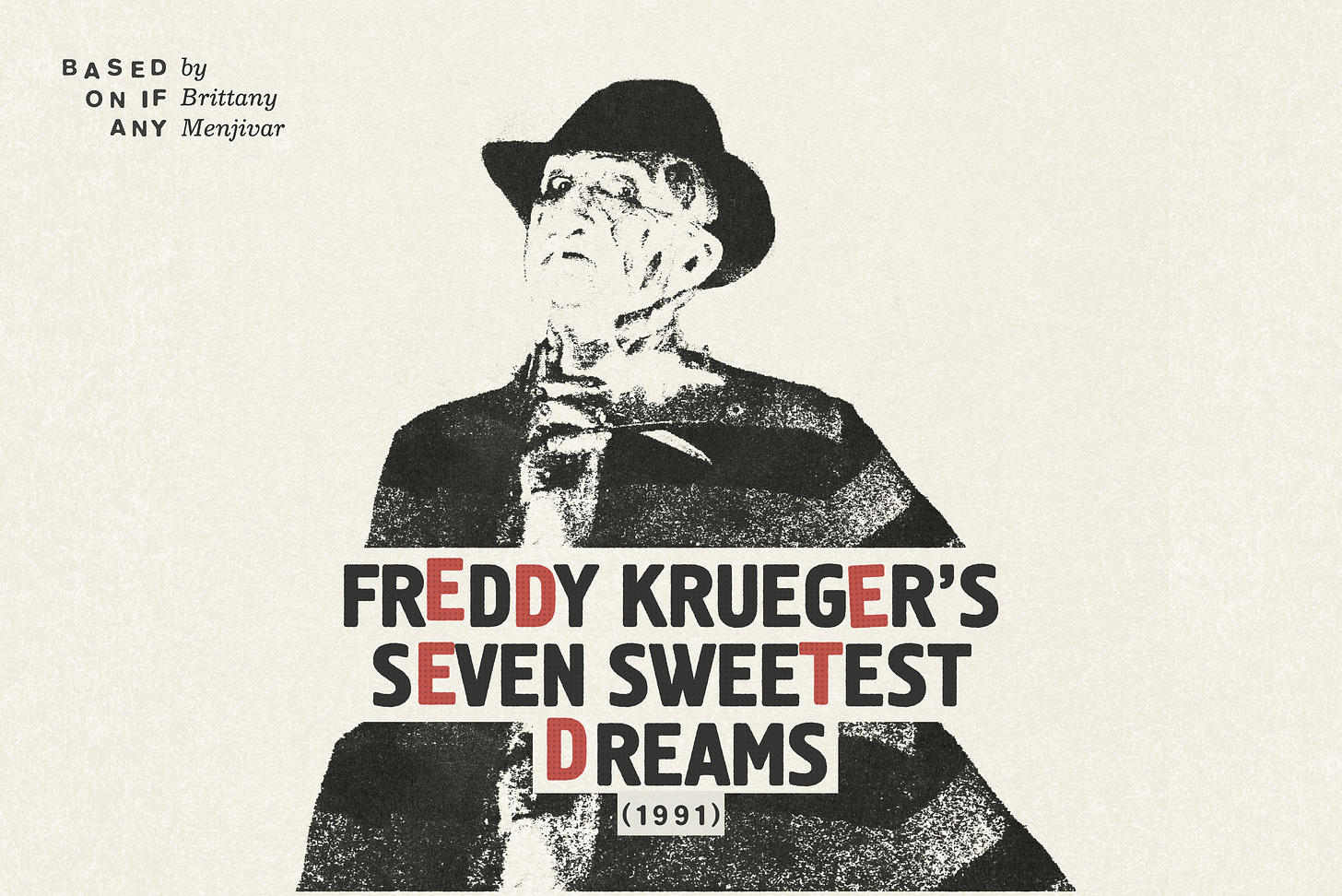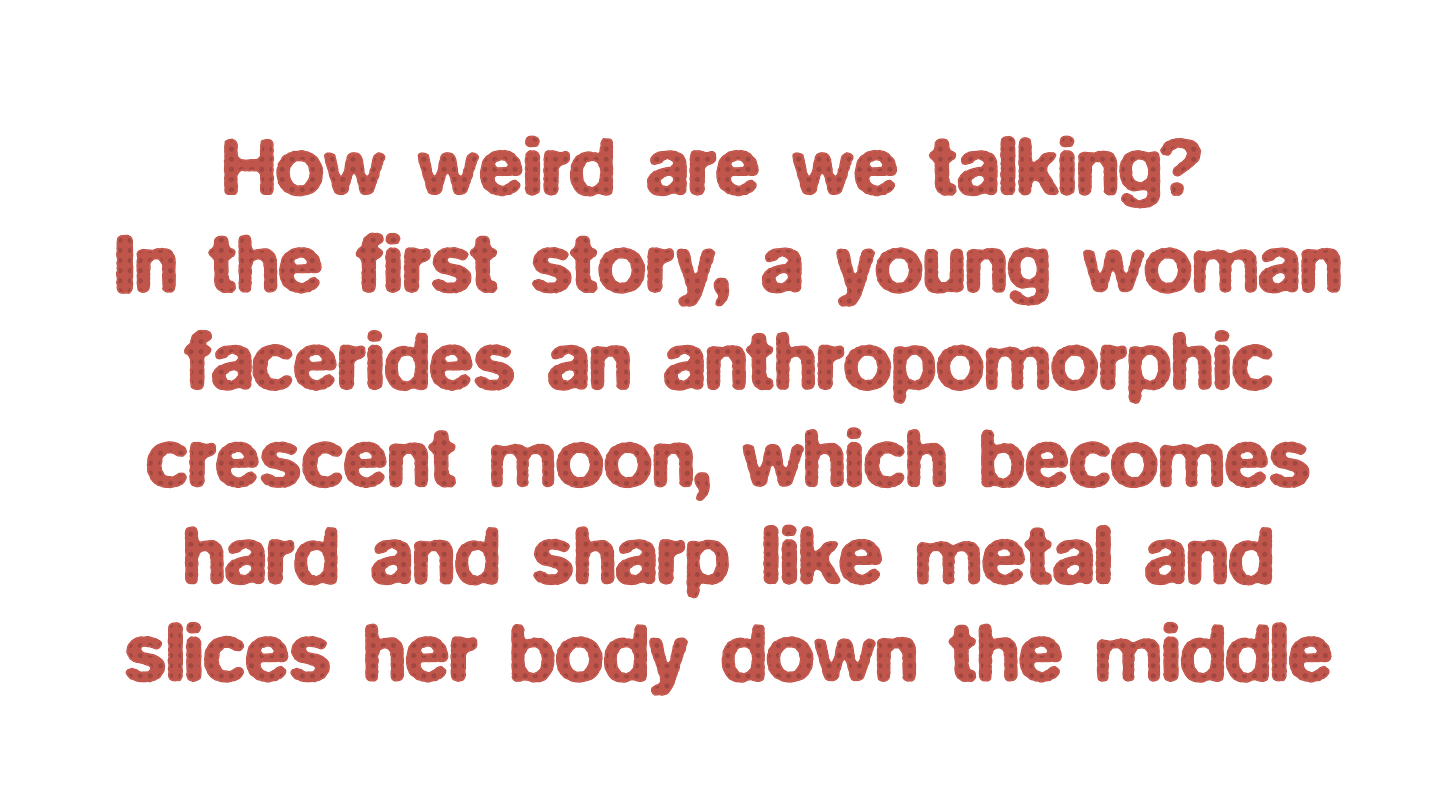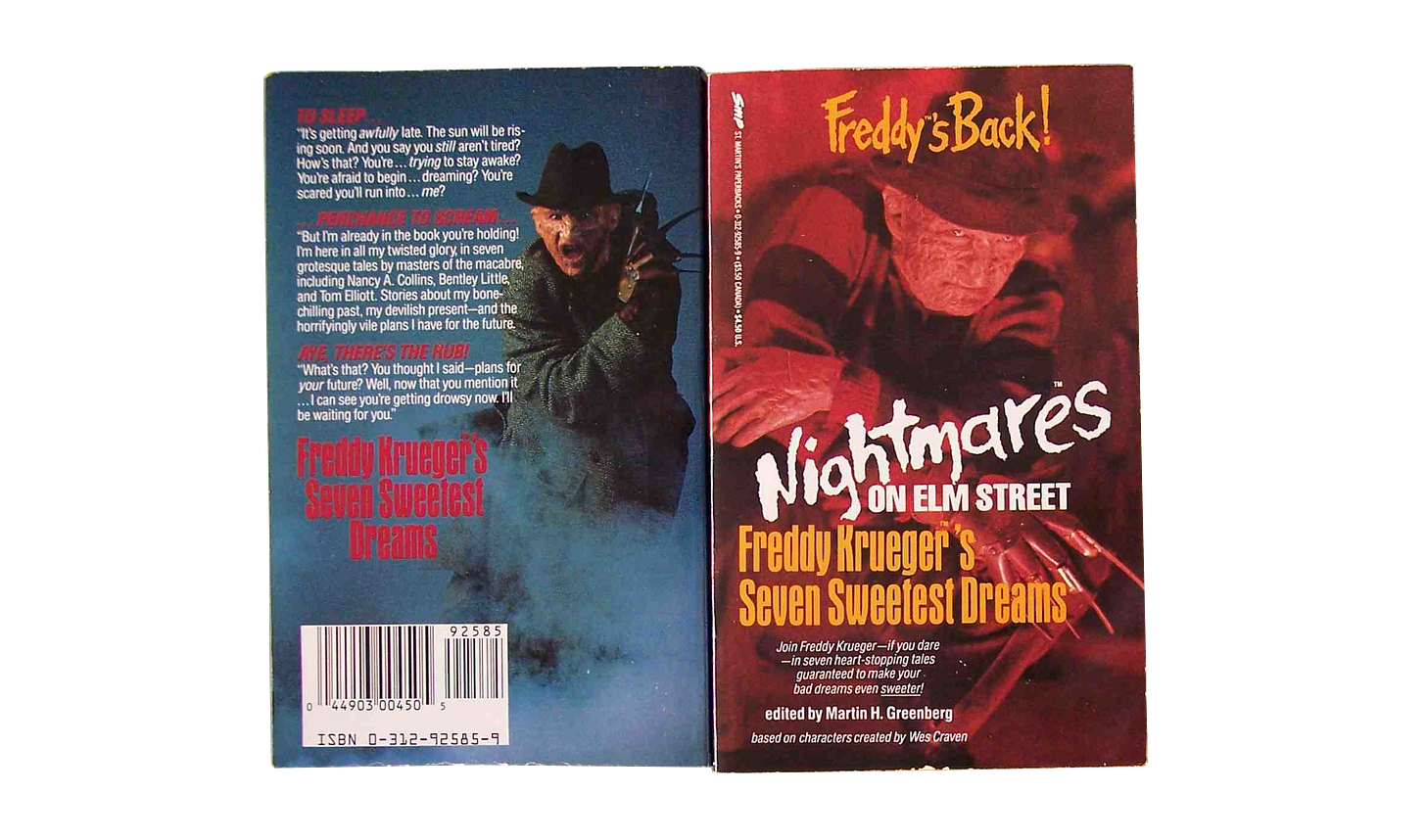Based On, If Any: Freddy Krueger’s Seven Sweetest Dreams (1991)
To Sleep, Perchance to Scream
Brittany Menjivar is watching adaptations. Previously, she watched Nosferatu, The Polar Express, Secretary, Rave Macbeth, The Great Gatsby and Grand Theft Hamlet.
Today, the book follows the movie.
We’re always debating, “Does the movie live up to the book?” Rarely do we have occasion to ask if the book lives up to the movie, but that wasn’t the case in the 20th century media landscape. Before social media campaigns, much-hyped merch drops with trending brands, and themed pop-up escape rooms, film execs turned to the literary medium as a method of cross-promotion—and thus, movie tie-in books were all the rage.
I’ve been fascinated by the novelization of films for quite some time. The way some people wistfully long to have been garden hermits or court jesters, I wish I had been hand-picked to turn Taxi Driver into a paperback back in ’76. The movie tie-in, to be clear, isn’t quite dead: the genre thrives when it comes to sci-fi IP (according to a 2015 NYT article, Star Wars novels have sold over 125 million copies), and publishing companies such as Insight Editions have cranked out dozens of cookbooks based on Disney flicks. On a more highbrow note, Tarantino adapted his own Once Upon a Time… In Hollywood in 2021, bringing the form back into the spotlight with a #1 debut on the NYT Bestsellers List. Still, you’re far less likely to find a spin-off of your favorite blockbuster at your local bookstore, so when I stumbled upon a collection of short stories whose cover declared, “FREDDY’S BACK!,” my body quivered as if pierced by five long blades.
During quarantine, while so many people were losing themselves in Tiger King, I leapt back in time to the ’80s and Freddy, craving a sense of terror that had nothing to do with real-world circumstances. Of course I had to bring Freddy Krueger’s Seven Sweetest Dreams home—even though it cost a whopping $50 bucks. To be a horror fan is to be a completist.
Each story in the book is penned by a different author. I hadn’t heard of writers such as Nancy A. Collins and Bentley Little before reading, but a quick search told me that many had won Bram Stoker awards and achieved market success with horror series. Editor Martin H. Greenberg is famous specifically for compiling anthologies—he published over 1,000 of them. It makes sense that the book should take the anthology approach given that each film in the Nightmare on Elm Street series has a unique director1 and therefore a unique vision. There’s a great deal of variation amongst the films: the first is a self-serious slasher, the second has become controversial due to queer readings, and later installments embraced camp and humor more fully. I’ve never taken issue with this unevenness in tone. After all, what is a franchise but a journey into different filmmakers’ dreams—and what is the Nightmare franchise but a journey into different people’s dreams, period?
Upon cracking open the book, I was shocked by the heart and (tortured) soul that each author had put into their prose. The first story, Brian Hodge’s “Asleep at the Wheel,” is distinctly Gothic, almost mimicking Poe in its intensity. This is a pulp-y, ultimately silly tale about a teenage rock band mixed up in a love pentagon (as opposed to triangle), but Hodge describes instruments as “accoutrements of life brought along to chase away the dismals.” Later on, in William Relling Jr.’s “Le Morte de Freddy,” a hypnotherapy patient’s unpunctuated internal monologue takes on the affecting cadence of prose poetry. Greenberg chose well; his writers, all true horror aficionados, are clearly having fun rather than functioning as mere hired hands.
As far as plot goes, some stories are stronger than others. It’s exciting to see how additional characters from the Freddy Cinematic Universe are woven into the narratives. In “Asleep at the Wheel,” for example, the teens name their band after Nancy Thompson, central protagonist of the first film and a recurring character in the franchise. “Le Morte de Freddy” stars Dr. Neil Gordon (and references Kristen Parker) from Nightmare 3: Dream Warriors, and Philip Nutman’s “Dead Highway, Lost Roads: A Fairy Tale Written in Blood on a Dead Man’s Back” (how’s that for a title?) centers largely on Alice Johnson from Nightmare 4: The Dream Master. But when the writing fails to establish a meaningful connection to the source material, I feel the lack. Tom Elliott’s “Briefcase Full of Blues” is one such instance: an overcomplicated yarn about a woman trapped in a pen (?),and it’s attached to Krueger only incidentally. (It’s also one of two stories that deploy the cross-dressing villain—a trope that isn’t just offensive by modern standards, but also reads as a lazy attempt to shock.)
Stories where the writers are willing to take major creative swings with the IP—as if ideating their own sequels—pay off. “Asleep at the Wheel”’s fixation upon the deceased Nancy’s legacy offers a clever meditation on the way adolescents attach themselves to history in the process of trying to develop their own identities. In “Le Morte de Freddy,” a doctor erases Freddy’s existence by astral projecting to a parallel universe, marrying Freddy’s mother, nicknaming the boy “Fred” instead, and raising him lovingly, such that he becomes a priest who is willing to hop timelines in order to fight Evil Freddy to the death. Insane, but my eyes were glued to the page. The trippy, abstract scenes of “Dead Highway, Lost Roads”—a fan favorite according to GoodReads—didn’t personally resonate with me, but a subplot in which an alternate, Freddy-adjacent history for the Green River Killer is invented certainly piqued my interest. The slasher genre already requires the suspension of disbelief, so why not go for the big guns?
Seven Sweetest Dreams delves even more deeply into absurd territory when it comes to grisly imagery. Since Freddy abides by dream logic rather than real-world rules, The Nightmare franchise is distinguished by especially innovative death scenes. This anthology boasts no shortage of similar spectacles and, thanks to the writers’ deftness, they’re just as vivid on the page as they are on the screen. How weird are we talking? In the first story, a young woman facerides an anthropomorphic crescent moon, which becomes hard and sharp like metal and slices her body down the middle. In “Dead Highway, Lost Roads,” a man hallucinates himself into a nursing home where the residents turn into birds—including Freddy, who caws “Nevermore.”
At the end of the night, the most compelling aspect of Seven Sweetest Dreams is the fact that this officially licensed compilation of fanfiction exists. Across multiple stories, characters talk about Freddy as a manifestation of fear, of rage; a scapegoat; a vessel for delusional self-empowerment. He trudges on through our nightmares, undead, because he can be whatever we want him to be—as long as we keep dreaming.
BRITTANY MENJIVAR studied creative writing and film at Yale University. Now, she works and plays in the City of Angels. Britt’s a columnist for the Los Angeles Review of Books, the author of poetry and prose collection Parasocialite, the screenwriter behind award-winning thriller short “Fragile.com,” and the co-founder of literary reading series Car Crash Collective.
other than the original and New Nightmare, both of which were helmed by Wes Craven himself




